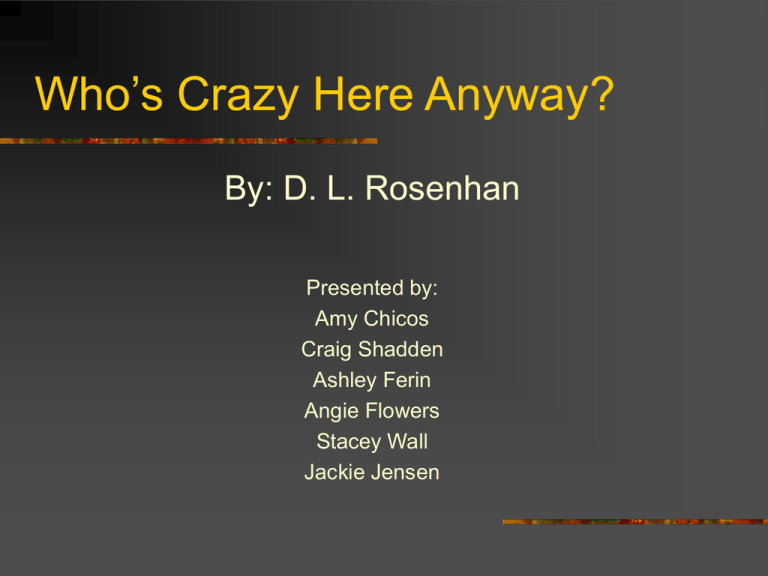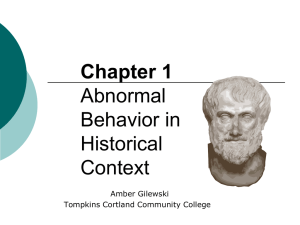Who’s Crazy Here Anyway? By: D. L. Rosenhan Presented by: Amy Chicos
advertisement

Who’s Crazy Here Anyway? By: D. L. Rosenhan Presented by: Amy Chicos Craig Shadden Ashley Ferin Angie Flowers Stacey Wall Jackie Jensen The question of how to discriminate between normal and abnormal behavior is fundamental in psychology Definition of abnormality key in determining whether or not someone is mentally ill and largely determines treatment. Criteria used to determine abnormal behavior Bizarreness of Behavior This can be a subjective judgment but some behaviors are obviously bizarre. Ex. Washing your car while it is raining Criteria cont. Persistence of Behavior Abnormal behavior may be exhibited occasionally, however to be considered mental illness it needs to occur on a regular basis over time. Ex. Dancing down the street every day Criteria Cont. Social Deviance When a person’s behavior radically violates the expected norms of society. Ex. Thinking you see a large penguin when there isn’t one present. Criteria Cont. Subjective Distress When a person is aware of their own psychological difficulties. This can be very helpful to mental health professionals when making a psychological diagnosis. Ex. When somebody is aware of their fear of heights. Criteria Cont. Psychological Handicap When a person finds it impossible to be satisfied with life due to psychological problems. Ex. A person who fears success sabotages each new endeavor in life. Criteria Cont. Effect on Functioning The extent to which the behavior affects the person’s ability to live the life that he/she desires. Ex. While it may be weird to stand on your bed every night and sing the National Anthem, it isn’t considered abnormal unless it has some negative effect. Rosenhan, D.L. (1973) Study David Rosenhan’s purpose was to question the ability of mental health professionals to truly distinguish between mentally ill and mentally healthy people. He also wanted to explore the consequences of inaccurate diagnoses. Method Rosenhan enlisted eight subjects to serve as pseudopatients. 3 women, 5 men 1 graduate student, 3 psychologists, 1 pediatrician, 1 psychiatrist, 1 painter, and 1 homemaker. Method, Cont. The subject’s mission was to present themselves for admission to 12 psychological hospitals in the United States. They would complain of hearing voices that said “empty,” “hollow,” and “thud.” They acted completely normal otherwise. All but one person was admitted with schizophrenia. Once in the hospital they acted normal. Results Length of hospital stay for the pseudopatients ranged from 7 days to 52 days with an average of 19 days. Key finding: not one of the pseudopatients was detected by anyone on the hospital staff. 35 of 118 real patients in the hospitals realized the pseudopatients were faking their illness. Discussion This study demonstrated that normal people cannot be distinguished from the mentally ill in a hospital setting. This is because of the influence of the hospital setting on the staff’s judgment of the patient’s behavior. Significance of Findings It appeared that the sane could not be distinguished from the insane in hospital settings. “The hospital itself imposes a special environment in which the meaning of behavior can be easily misunderstood. The consequences to patients hospitalized in such an environment…seem undoubtedly countertherapeutic.” Significance cont. Danger of diagnostic labels Once a person is labeled as having a certain illness they are treated differently. All behavior and personality is then seen as stemming from the disorder. This can also become self-confirming. Criticisms Main Critic: Spitzer Argued that Rosenhan’s methods didn’t actually invalidate psychological diagnostic systems. Not difficult for pseudopatients to lie their way into a mental hospital. Admissions are usually based on verbal reports. Symptom variation is normal once admitted. Questions Do you think that labels for mentally ill people should be completely eliminated? Why or why not? Have you or anyone you know ever treated anyone differently based on their “label”? Do you think the labels applied to people become part of their central characteristic or personality trait? Would you ever volunteer to do a study like this?









